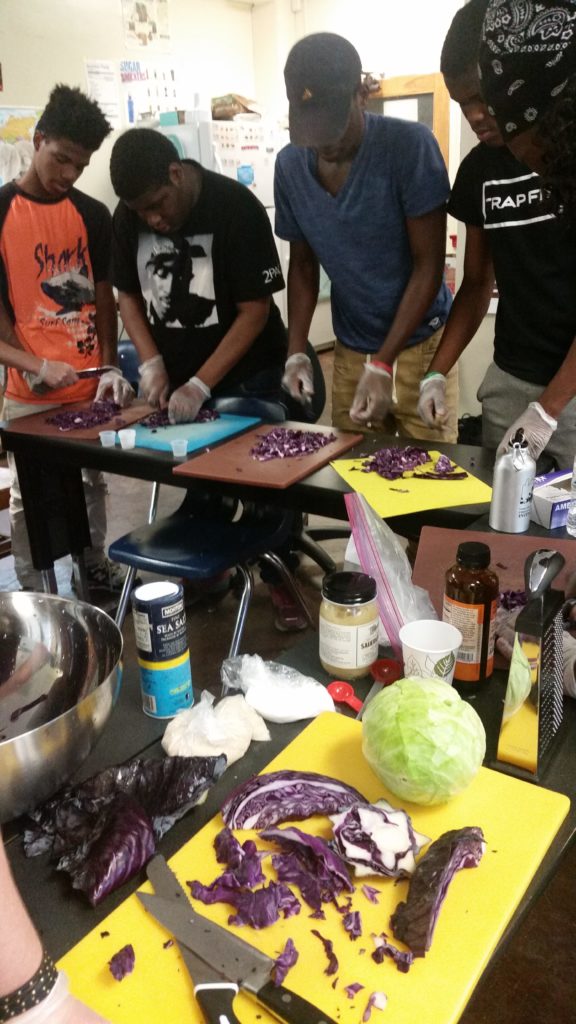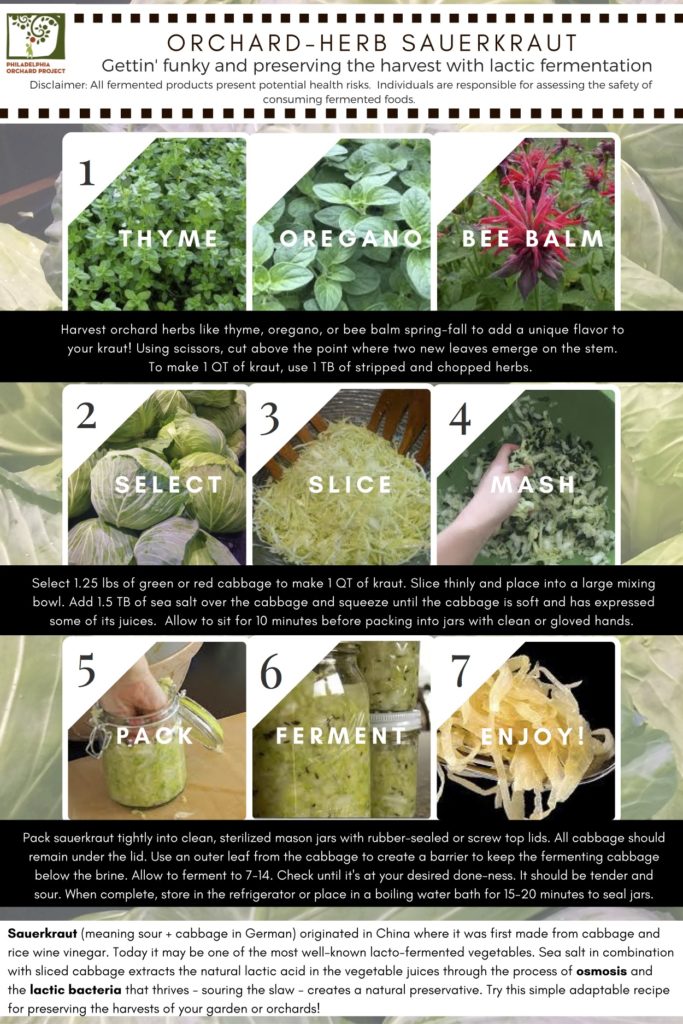If there’s one thing we continually learn in offering our School Orchard Program it’s that culinary classes are always a hit with students and teachers alike! They’re hands-on and sensory-rich, foster team-work, collaboration, and creative thinking, and offer educators a breadth of content integration possibilities. Take for instance a recent summertime lesson on fermentation we offered at Sayre High School in West Philadelphia, where students of the after-school and summer garden programs, cultivate a garden of assorted vegetable and fruit crops they sell twice weekly (Tues. 3:45-5 @ Sayre Health Center and Weds. 4-5 @ Red Cross House (4000 Powelton Ave) in their CSA Good Food Bag for the surrounding community with special focus upon those using SNAP/EBT.
The hands-on session provided an entry point to discussing regional culinary traditions informed by planned and local plant ecologies, botanical families of plants featured in the recipe and the school garden & orchard, and culinary science and biological processes, all while creating space for students to hatch new ideas of entrepreneurship & creating value-added products for the program from the landscape (a particular desire students expressed). What can we say? Orchards lend themselves naturally to interdisciplinary learning that feeds curiosity and awareness of interdependence at the same time they nourish with fresh food.
The lesson began by situating the timeliness of the material seasonally — asking students what methods of food preservation they might use at the peak of the season when they have more vegetables, fruits, and herbs harvested than they know what to do with. They shared a number of responses: canning, freezing, drying, pickling, and of course, donating and sharing the harvest with others — and then the funky one that packs a particular punch on the palette — fermentation. We sampled examples of fermented foods like sourdough bread, sauerkraut, and fizzy, fermented tea-beverage, kombucha, noting the signature saliva-producing lactic bite of foods gone funky, explored the chemistry that’s enacted in the process, and then delved into the hands-on sauerkraut-making portion that could incorporate orchard herbs like bee balm, oregano, and thyme, commonly planted in most if not all POP community orchards.

During our session together, students also drew personal parallels to their own culinary memories and traditions. One student, Jonathan, shared how sauerkraut always reminded him of his grandfather because they enjoy kraut-topped hot dogs at baseball games together every summer. We also discussed how cultured foods literally create culture (not only for groups of people), but also for the populations of bacteria, fungi, and yeast of a particular region/place that can be shared over many years, topographies, and borders. Take a look at Ione Christensen of Canada, for instance, who’s been tending to a 120-year old culture of sourdough that traveled to her from her great-grandfather back in 1897. That’s one kickin’ culture!
What’s more as fodder to ponder, is what as fermentation revivalist Sandor Katz calls, ‘the miracle of coevolution – that the bacteria that coexist with us in our bodies enable us to exist.’ In The Art of Fermentation: An In-Depth Exploration of Essential Concepts and Processes from Around the World, Katz cites microbiologist Michael Wilson who notes “each surface of a human being is colonized by microbes exquisitely adapted to that particular environment” and in the era of the ‘war on bacteria,’ he advocates “the well-being of our microbial ecology requires replenishment and diversification now more than ever.” Equally relevant to the health of our digestive and immune systems in nourishing rich microbiomes, we also take this point for its application to organic orcharding. When we boost fertility and build fungal-rich soil through sheet-mulching, compost tea application and foliar sprays, the plants of the orchard thrive and and sustain themselves more readily from fending off other fungal or bacterial diseases, as noted organic orchardist and author Michael Phillips proposes.
May it be that the standards-based lesson materials available here as a PDF download — along with picture guide and handout — contribute in small part to the aim of working in ever-closer harmony with the microbes of yeast, fungi, and bacteria that support the ecology of the orchards, our bodies, ourselves.
SUPPORT US! If you found this entry useful, informative, or inspiring, please consider a donation of any size to help POP in planting and supporting community orchards in Philadelphia: phillyorchards.
